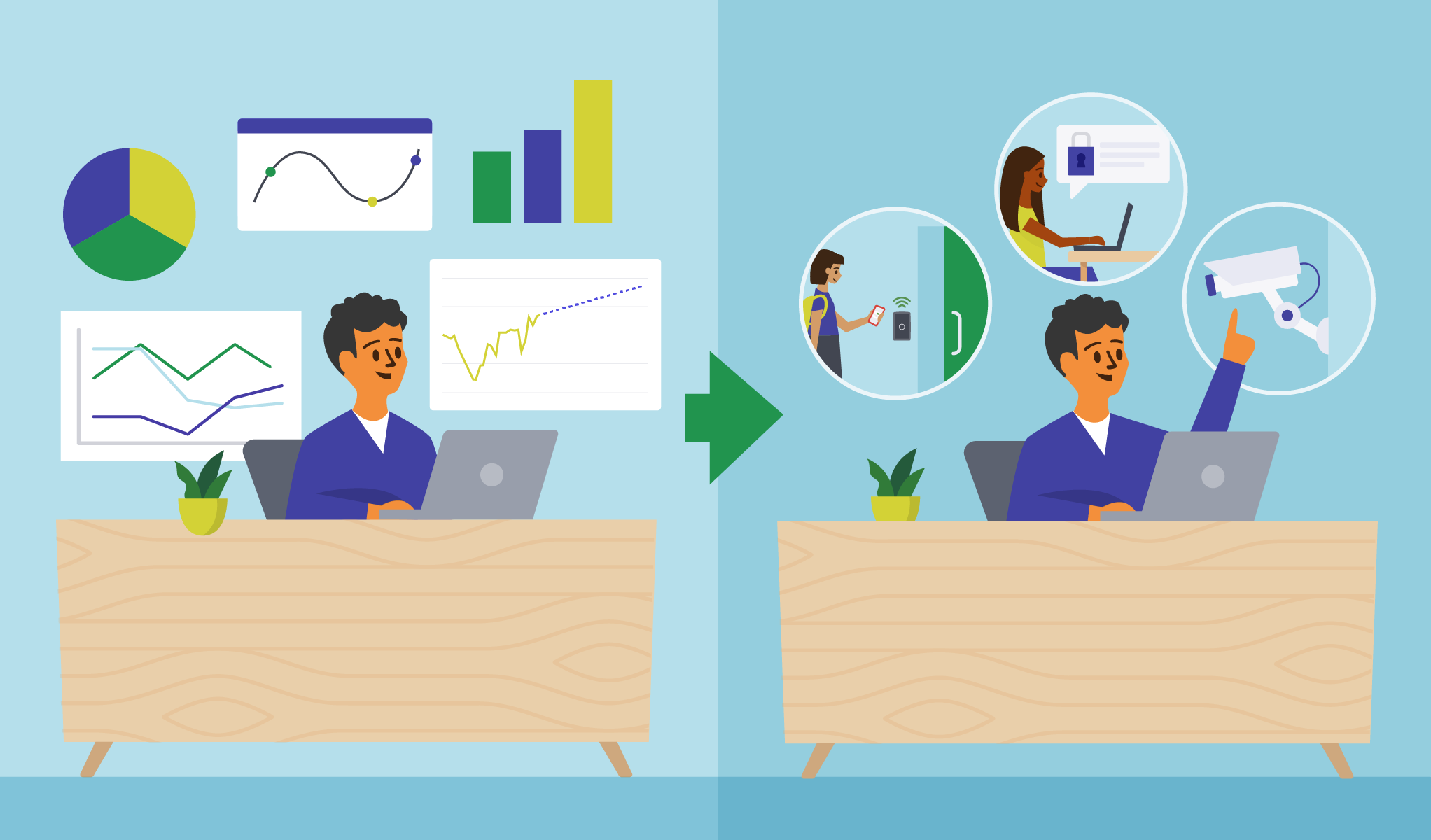Welcome back to your workplace analytics masterclass series, where we’ll explain how an integrated platform can create a more connected workspace.
Access to real-time workplace data wasn’t a thing a few years ago. But, the office environment has changed drastically since then. Workplace leaders are now looking for any clues that can help them navigate economic headwinds and new security threats. Unfortunately, many still have to piece together data—siloed across their numerous tools and point solutions—to get a clear view of their workplace context. This process is time-consuming, cumbersome, and prone to human error.
We’re here to make sense of this all. Below, we’ll cover:
- The questions workplace leaders need answers to
- How to capture data with an integrated platform
- How to surface and apply workplace data
- Key workplace data points to track
The questions workplace leaders need answers to
Concerns over costs and employee efficiency have never been higher. Executives have become more cautious about spending money on new tools, resources, and real estate. Workplace leaders now have to explain their rationale for pretty much anything they do. Whether it's changing a seating chart or justifying their budget, the onus is on them to have all the answers. Sound familiar?
You’re not alone. Here are a few questions that you should be ready to answer on a regular or ad hoc basis:
- How many people are in your buildings on any given day?
- How often are your buildings receiving visitors, and what kind?
- How are you enforcing consistent security measures across your locations?
- What areas are being underutilized?
- Are there any spaces that are routinely over capacity?
- How much is your unused or underutilized space costing the organization?
Gathering this information from separate point solutions can be time-consuming. And there’s a risk of that data being incomplete and inaccurate. Workplace platforms can help.
These platforms pull data (e.g., desk bookings, room usage, and employee attendance) and tie them into one, unified dashboard. This centralized view gives real-time insights into your workplace occupancy and space utilization. Knowing how people are using certain areas within your locations can enable your team to:
- Reconfigure or renovate existing spaces
- Update or roll out new security protocols for building access
- Invest in additional real estate
- Renew or discontinue leases due to space usage trends
- Open up opportunities for alternate locations better suited for employee needs
How to capture data with integrated platforms
If you’re using multiple workplace tools, you already have access to a treasure trove of data. The challenge is tying all of them together to get a clear picture of how your workspace is operating. Here are a few ways an integrated platform can help you uncover key workplace insights:
- Workplace integrations. A major advantage of a platform is its ability to integrate with tools you already use, like access control and calendar systems. Workplace integrations meet employees where they are (i.e., in the tools they already use), so there's no heavy lifting necessary. The data is passively shared between systems, which can help cut manual tasks and unlock other use cases. For instance, an employee can schedule a meeting in Microsoft Teams, and this meeting information will automatically show up on the office map and on displays outside of the meeting room.
- Digital check-ins. In workplaces, digital check-ins help track employee attendance, visitor entries, or room bookings. These systems typically use an app, a kiosk, or a QR code to enable visitors and employees to check in upon arrival. For visitors, check-ins can capture information like name, purpose of visit, and entry and exit times. Space booking check-ins can also provide information about how employees are using resources. This helps ensure folks have enough of what they need at the workplace.
- ID scans. Businesses that welcome visitors usually leverage ID scanning for identity verification and screening. During the sign-in process, visitors use a tablet to scan their government-issued IDs. From there, the platform records their information (e.g., name, date of birth, and photo) and confirms their identity. The visitor's data is then automatically uploaded to the workplace platform's database. You can use this data to keep track of who is in the building, check security, and ensure you're adhering to compliance standards.
- Visitor pre-registrations. When visitors fill out their information before arriving, it can help optimize reception resources and scheduling. You can capture key data, like total number of visitors, their reasons for visiting, and peak times.
How to surface and apply workplace data
Today, access to the right data—at the right time—is critical. But ensuring you have all the information you need can be challenging without an integrated platform like Envoy. Solutions like these aggregate data spread across your systems and provide a clear view of your workplace. The result? Workplace leaders can leverage actionable analytics and insights to better interpret their data.
Here are a few time-saving features and capabilities that make it possible:
- Automated reporting. A platform can generate reports from the data it collects and send them to the right people. That way, stakeholders can keep a pulse on workplace foot traffic and space usage trends.
- API integrations. An open platform allows you to easily combine and study different types of data in one place. Many platforms offer API integrations like HR systems, security platforms, or communication tools.
- Custom notifications. You can set up these platforms to send custom alerts or notifications based on certain conditions (e.g., when maximum capacity has been reached). These alerts can be sent via email or company communication channels, like Teams or Slack.
- Access to location-specific data. A workplace platform can give admins a clear view of both global and location-level data. This information can help a company decide whether to grow, downsize, or close an office in a particular area.
Key workplace data points to track
The workplace metrics you monitor can greatly affect your security plans and budget. Without the correct data, you can risk making decisions based on incomplete or inaccurate information. The right data can reveal insights that can prove critical when forecasting future needs. Below are some recommended metrics to keep tabs on:
- Employee attendance. This tells you how many employees are onsite each day and how this changes during the week. Analyzing attendance trends helps you understand peak usage and overall occupancy trends.
- Entry and exit data. Workplace platforms can track when and how often people enter and leave your space. This can provide you with intel on peak hours, average duration of stay, and how your space is used. Having this real-time data is especially critical during emergencies when every second counts, while planning the layout of your workspace, and when right-sizing your company’s real estate. Solutions like Envoy Workplace track onsite attendance and provide recommendations for space optimization. For instance, if attendance falls significantly below capacity, Envoy might suggest consolidating or repurposing underused areas to improve resource allocation and reduce costs.
- Visitor patterns. By looking at your visitor data, you’ll have a better idea of the type of visitors that are coming onsite. This information helps with improving the visitor experience and identifying security gaps. It can also help you decide whether a location needs a receptionist or can use a self-check-in system, like Envoy's Virtual Front Desk.
- Volume of denied entries. This can tell you how well your system is working and where/when intruders make the most attempts to enter.
- Meeting room utilization. Many platforms offer dashboards that show how meeting rooms are used. They share insights based on room bookings by day, the use of space-saving features, and the popularity of specific amenities. This can help you identify patterns in how rooms are used and keep track of their use over time.
- Desk usage. This metric tracks desk bookings by team, department, or floor, which can inform seating charts (for assigned or hot desking) and broader space planning decisions. Solutions like Envoy can even suggest ways to optimize underused areas based on desk booking trends. For example, if an area of your office has a lot of desk bookings but others don’t, you can repurpose desk space for something else (e.g., casual cafe-style seating for impromptu collaboration or a dedicated area for phone booths) based on employee needs and feedback.
- Overall workplace efficiency. This measures how effectively your space is being utilized by analyzing key metrics like attendance, desk usage, and room utilization. By understanding your overall efficiency in real time, your team can identify opportunities to optimize your space. Platforms like Envoy will also factor in cost per square foot and utilization rates, helping you uncover inefficiencies, make targeted adjustments, and improve resource allocation to reduce unnecessary expenses.
- Area-specific access. Workplace platforms can also monitor which areas are accessed most. They also highlight areas that are over or underutilized or need heightened security.
- Benchmarking. Some platforms provide benchmarking insights, allowing you to compare your workplace data against similar organizations to understand performance trends, such as desk usage or meeting room occupancy, in the context of broader industry standards. With these insights, your team can assess if your space utilization aligns with typical practices, pinpoint areas for improvement, and make data-driven decisions about space optimization and resource allocation.
Using integrated platforms to improve the onsite experience
Solutions like Envoy provide workplace leaders with real-time data to enhance both admin and employee experiences. Integrated platforms can surface insights on who’s coming into the office often enough to warrant an assigned seat. This is especially useful for planning office layouts and seating charts.
These platforms also ensure that office space is used efficiently. For example, Envoy can recommend smaller rooms for meetings with only two attendees, remind meeting organizers to release rooms if attendees are not onsite, and recommend repurposing your space to better match actual use patterns.
Simply having data isn't enough. It needs to be packaged and presented as actionable insights. Integrated platforms like Envoy make leveraging workplace data easier and more effective for confident decision-making.
–
Take Envoy for a test ride. Check out our interactive demos to learn how to enhance your workplace.
Read more
Searching for a visitor management solution? Learn what to look out for and how to choose the best tech for your team.
Managing your space well doesn’t have to be difficult. But if you want to be successful, you need the right approach.
A well-run workplace can set your team up for success. Learn why workplace management matters and how to do it right.
Workplace security is critical to the future of your business. Learn why it matters, what threats to watch for, and how to strengthen your workplace security plan.
In this post, we’ll explore what workplace compliance is and how to build a compliance culture for your organization.
With more folks sending personal packages to the workplace, having a sound mailroom management system in place is key.










